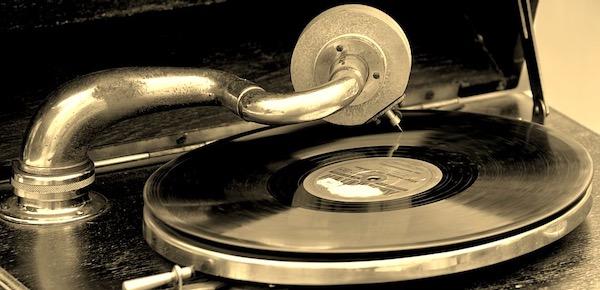The Evolution of Audio: A Brief History

It all started as everything did, of course, with Thomas Alva Edison. I like to think I was named after him (apart from the Alva and Edison part), but actually it was for my grandfather, who to my knowledge didn't invent anything apart from me.
But others besides Edison were also involved in those ground-breaking audio years. Those early years were rife with competition, and likely copyright lawsuits as well. But Edison is the name we all remember as having revolutionized home entertainment. Before that, music at home meant the family piano (for those who could afford one) and family or friends who could play it. The playlist was limited to the sheet music available from the general store. But with a gramophone, a vigorous mechanical windup produced sound from a horn attached more or less directly to a "needle" scrapping along the grooves on a cylinder or disc. The world of home audio was born.
The shellac disc eventually replaced Edison's early cylinders. Electronic amplifiers and loudspeakers came later, bringing listeners closer to reality (though claims of "indistinguishable from the real" thing have continued throughout the history of audio reproduction, even in that era of wind-up gramophones).
In the early 1950s the vinyl LP appeared. It was mono at first but evolved into stereo by the end of the decade, further revolutionizing music at home and inarguably inspiring the birth of the hi-fi business. There was far more to the sound available on an LP than the meager one-box record players of the day could extract, as an entire generation of new hi-fi entrepreneurs and music/audio fans soon discovered. Names such as Marantz, McIntosh, Acoustic Research, Klipsch, Allison, Kloss, and others come to mind. So do iconic LP labels such as Decca/London and Mercury), many of whose LPs, both mono and stereo, are considered state-of-the-art even today by vinyl aficionados.
The '50 probably brought the most significant changes in what we expected from both home entertainment and movies. Early television, all 12-inches of fuzzy, black-and white magic, would inspire its own revolution into what we have today. When filmmakers and theater-owners panicked as folks started going to the movies in dribs and drabs rather than weekly (or more) as in the past, the movies changed forever to give us "Glorious Technicolor, Breathtaking Cinemascope and Stereophonic Sound." It brought audiences back to the theaters, but never to the WWII or pre-WWII levels.
It took a few years before the home audio business caught up with the movies. Home video was still decades away from what the theater experience offered, but by the late '50s the LP became 2-chanel stereo. Your great-uncle Bob had to ditch his mono setup and figure out how to afford two new speakers, and a new preamp and amp (all tubes of course solid state in that time still meant how water was turned into ice cubes in the freezer). Bob also needed a new stereo phono cartridge for his Thorens (or, just a few years later, perhaps AR) turntable. LPs hovered around the princely sum of $6 (that's almost $60 today, making today's new LPs a near bargain at around $30!)
Open reel tapes, and tape decks to play them on, made a minor splash in the early '60s as a relatively expensive but (unlike vinyl) mostly wear-resistant format. But consumer audio on tape never advanced beyond niche status, despite its ability to carry more than two channels (never fully realized in the consumer space).
But there was a serious attempt in the early '70s to put 4-channels onto an LP. Known as Quad, it required a special phono cartridge. But it fizzled in short order. The market wasn't yet ready for surround sound at home, and even surround sound in movie theaters was still generally limited to a few first-run theaters in the largest cities. For the general public, 2-channels at home remained sufficient, an attitude that persists with many audiophiles to this day.
Compact Cassette, 8-Track (for cars) and something called the Elcaset enjoyed brief runs in the late '70s and early '80s. But they've long-since disappeared, apart from starring appearances in Guardians of the Galaxy films.
But everything changed again in the early '80s. The CD format came to town, squeezing an hour or more of digitally-recorded music onto a 5-inch disc (though at first most releases came from analog originals converted to digital for the CD release). At last you didn't need to turn over an LP to hear the last 30-minutes of the album. Ticks and pops were gone. Dynamic range was vastly increased. Wear was no longer an issue, nor was disc warpage. Nirvana at last!!
Not quite. I bought one of the first Sony CD players, together with a few early discs, when stationed in the Air Force in Germany. CDs appeared there a few months before they turned up in the States. Stereophile's then editor, J. Gordon Holt, initially raved about the new format. As a dedicated classical music fan, he likely responded to not having get up to turn over an LP midway through his favorite symphony. In addition, classical music's loudest, most challenging passages often come at the conclusion, which typically ends up on the inner grooves of an LP. That's where the vinyl format is most compromised but a CD doesn't even break a sweat.
But unlike Gordon, my initial experience with that first CD player was anything but favorable. The sound was harsh and edgy. But fortunately CD has improved so dramatically over the years (both on the recording and playback sides) that it's now my main go-to audio format, despite the ongoing popularity of vinyl LPs to a significant niche of enthusiasts. Some of those vinyl-istas are attracted to its odd quirkiness (to a young crowd everything old is new again apart from corded, rotary-dial telephones). But many serious audiophiles favor LPs for their unique sound. My reservations about vinyl involve the fact that it adds two additional, mechanical transducers to the playback chain, the LP cutting lathe and the phono cartridge. That's fine for the consumer, but an issue (for me) for a reviewer who's evaluating electronics or loudspeakers.
CD has now lasted an unusually long four decades. But while it's still kicking, it's now on life support and has been largely replaced by streaming, which offers a vast selection of music, convenience, portability and (at its best) superb audio quality. Other formats offering these advantages (such as the iPod) came before streaming, but they were absent the quantity of instantly available music and the same level of audio quality.
What comes next? Who knows, but as time passes something will likely appear that we can hardly imagine today. Receptive, cochlear implants perhaps, feeding us a continual stream of "carefully" curated music and news?





























































